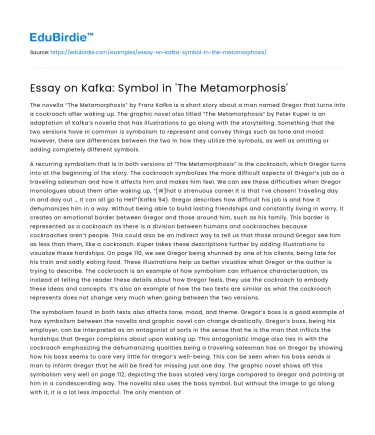The novella “The Metamorphosis” by Franz Kafka is a short story about a man named Gregor that turns into a cockroach after waking up. The graphic novel also titled “The Metamorphosis” by Peter Kuper is an adaptation of Kafka’s novella that has illustrations to go along with the storytelling. Something that the two versions have in common is symbolism to represent and convey things such as tone and mood. However, there are differences between the two in how they utilize the symbols, as well as omitting or adding completely different symbols.
A recurring symbolism that is in both versions of “The Metamorphosis” is the cockroach, which Gregor turns into at the beginning of the story. The cockroach symbolizes the more difficult aspects of Gregor’s job as a traveling salesman and how it affects him and makes him feel. We can see these difficulties when Gregor monologues about them after waking up, “[W]hat a strenuous career it is that I’ve chosen! Traveling day in and day out … It can all go to Hell”(Kafka 94). Gregor describes how difficult his job is and how it dehumanizes him in a way. Without being able to build lasting friendships and constantly living in worry, it creates an emotional border between Gregor and those around him, such as his family. This border is represented as a cockroach as there is a division between humans and cockroaches because cockroaches aren’t people. This could also be an indirect way to tell us that those around Gregor see him as less than them, like a cockroach. Kuper takes these descriptions further by adding illustrations to visualize these hardships. On page 110, we see Gregor being shunned by one of his clients, being late for his train and sadly eating food. These illustrations help us better visualize what Gregor or the author is trying to describe. The cockroach is an example of how symbolism can influence characterization, as instead of telling the reader these details about how Gregor feels, they use the cockroach to embody these ideas and concepts. It’s also an example of how the two texts are similar as what the cockroach represents does not change very much when going between the two versions.
Save your time!
We can take care of your essay
- Proper editing and formatting
- Free revision, title page, and bibliography
- Flexible prices and money-back guarantee
The symbolism found in both texts also affects tone, mood, and theme. Gregor’s boss is a good example of how symbolism between the novella and graphic novel can change drastically. Gregor’s boss, being his employer, can be interpreted as an antagonist of sorts in the sense that he is the man that inflicts the hardships that Gregor complains about upon waking up. This antagonistic image also ties in with the cockroach emphasizing the dehumanizing qualities being a traveling salesman has on Gregor by showing how his boss seems to care very little for Gregor’s well-being. This can be seen when his boss sends a man to inform Gregor that he will be fired for missing just one day. The graphic novel shows off this symbolism very well on page 112, depicting the boss scaled very large compared to Gregor and pointing at him in a condescending way. The novella also uses the boss symbol, but without the image to go along with it, it is a lot less impactful. The only mention of the boss in the novella is, again, when he is complaining about his job to himself, “If I didn’t have my parents to think about I’d have given in my notice a long time ago … talking down at your subordinates from up there, especially when you have to go right up close because the boss is hard of hearing”(Kafka 94). The image of pointing and looking down at subordinates is a dehumanizing visual that the authors want to portray, to further show the idea of how Gregor feels stripped of his humanity. The image offers a much clearer visualization of this concept than the novella, and that’s where the two versions start to detract and differ. The graphic novel has more creative liberty as it is not limited to text, but character design, colors, and different visual symbols such as the hourglass to help convey the original ideas Kafka wanted to portray.
Both versions of Kafka’s “The Metamorphosis” share very similar characterizations, tones, moods, and themes. However, the symbolisms used to convey these vary from being almost identical to having radical differences for the same concept. For example, the cockroach stays consistent between the two versions, not changing very much, while the boss gains extra characterizations in the graphic novel compared to the novella.






 Stuck on your essay?
Stuck on your essay?

